MGMT 240 SB55: Business Research Article Evaluation Assignment
VerifiedAdded on 2023/04/19
|7
|1705
|237
Report
AI Summary
This report presents a comprehensive review of a business research article by Schauer et al. (2015), which investigates the co-use of marijuana and tobacco among US adults from 2003 to 2012. The study, based on the National Survey on Drug Use and Health (NSDUH) data, aims to determine the impact of these substances on the US society. The methodology involves a national, cross-sectional survey with a large sample size, analyzing demographic trends and the concurrent use of both substances. Key findings reveal an increase in co-use from 2003 to 2012, particularly among males, females, and Hispanics. The authors conclude that co-use has increased, and recommend better surveillance. The review critically assesses the article's relevance, methodology, and limitations, highlighting the study's contribution to understanding the relationship between marijuana and tobacco use in the US, and the potential implications of legalization. The study's limitations include a focus on adults and adolescents, without analyzing national trends.
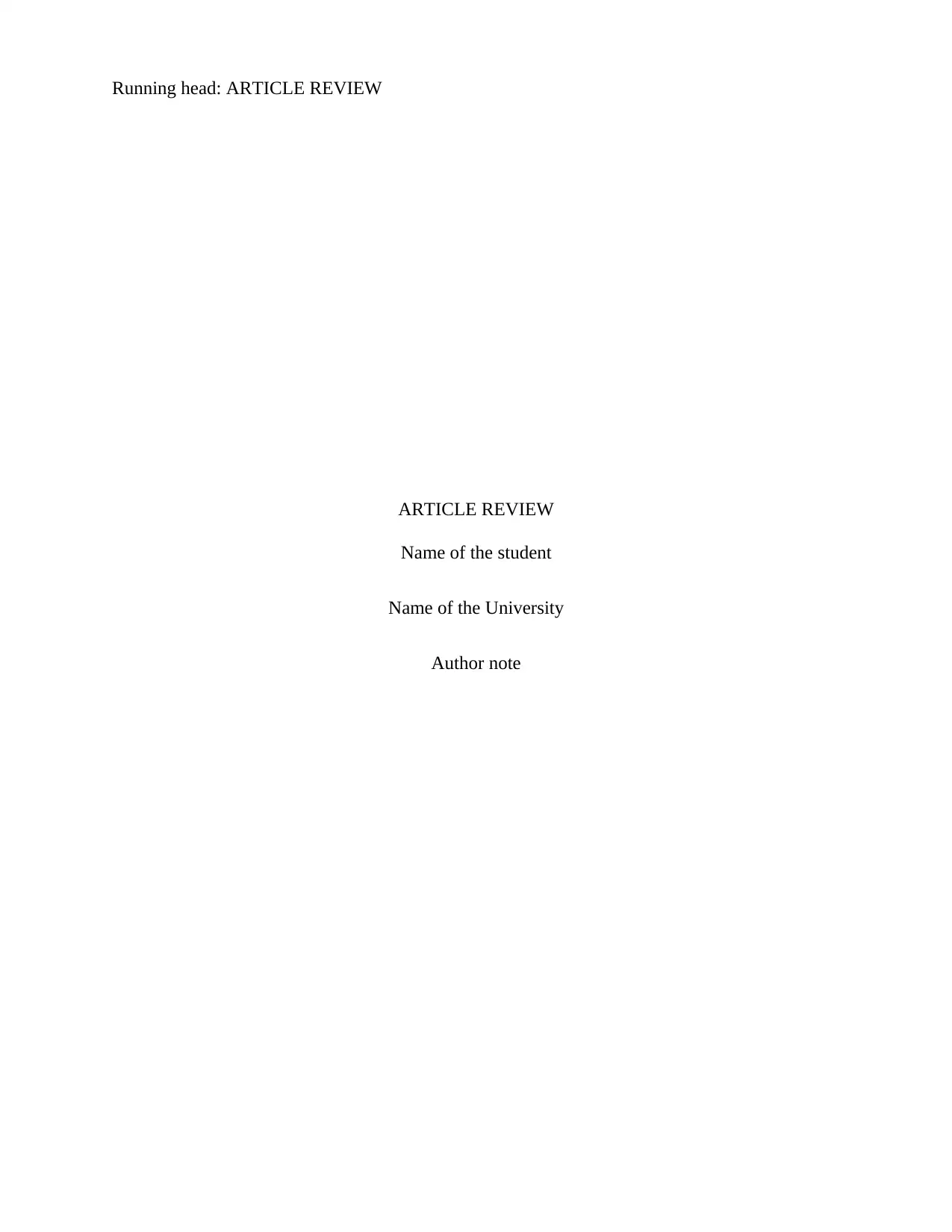
Running head: ARTICLE REVIEW
ARTICLE REVIEW
Name of the student
Name of the University
Author note
ARTICLE REVIEW
Name of the student
Name of the University
Author note
Paraphrase This Document
Need a fresh take? Get an instant paraphrase of this document with our AI Paraphraser
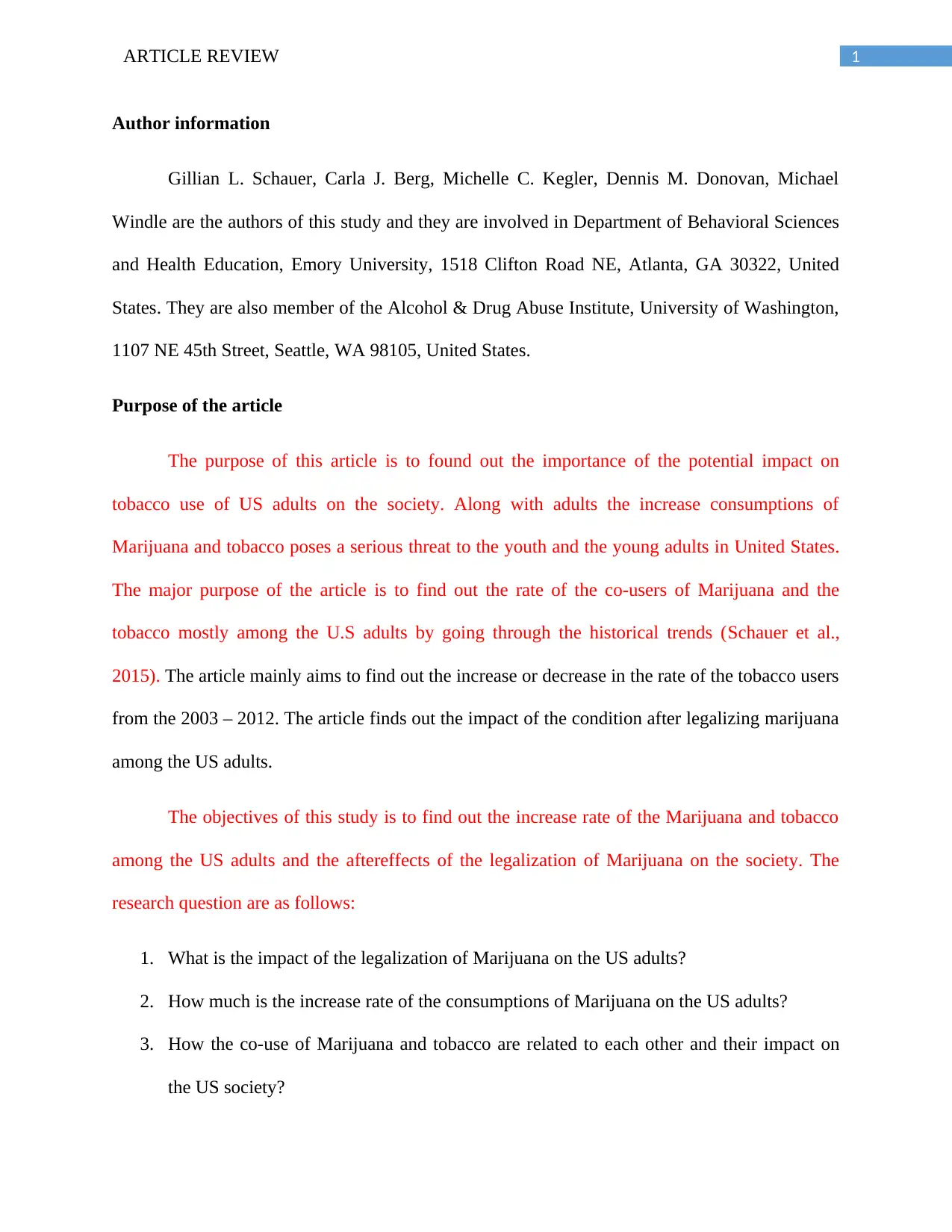
1ARTICLE REVIEW
Author information
Gillian L. Schauer, Carla J. Berg, Michelle C. Kegler, Dennis M. Donovan, Michael
Windle are the authors of this study and they are involved in Department of Behavioral Sciences
and Health Education, Emory University, 1518 Clifton Road NE, Atlanta, GA 30322, United
States. They are also member of the Alcohol & Drug Abuse Institute, University of Washington,
1107 NE 45th Street, Seattle, WA 98105, United States.
Purpose of the article
The purpose of this article is to found out the importance of the potential impact on
tobacco use of US adults on the society. Along with adults the increase consumptions of
Marijuana and tobacco poses a serious threat to the youth and the young adults in United States.
The major purpose of the article is to find out the rate of the co-users of Marijuana and the
tobacco mostly among the U.S adults by going through the historical trends (Schauer et al.,
2015). The article mainly aims to find out the increase or decrease in the rate of the tobacco users
from the 2003 – 2012. The article finds out the impact of the condition after legalizing marijuana
among the US adults.
The objectives of this study is to find out the increase rate of the Marijuana and tobacco
among the US adults and the aftereffects of the legalization of Marijuana on the society. The
research question are as follows:
1. What is the impact of the legalization of Marijuana on the US adults?
2. How much is the increase rate of the consumptions of Marijuana on the US adults?
3. How the co-use of Marijuana and tobacco are related to each other and their impact on
the US society?
Author information
Gillian L. Schauer, Carla J. Berg, Michelle C. Kegler, Dennis M. Donovan, Michael
Windle are the authors of this study and they are involved in Department of Behavioral Sciences
and Health Education, Emory University, 1518 Clifton Road NE, Atlanta, GA 30322, United
States. They are also member of the Alcohol & Drug Abuse Institute, University of Washington,
1107 NE 45th Street, Seattle, WA 98105, United States.
Purpose of the article
The purpose of this article is to found out the importance of the potential impact on
tobacco use of US adults on the society. Along with adults the increase consumptions of
Marijuana and tobacco poses a serious threat to the youth and the young adults in United States.
The major purpose of the article is to find out the rate of the co-users of Marijuana and the
tobacco mostly among the U.S adults by going through the historical trends (Schauer et al.,
2015). The article mainly aims to find out the increase or decrease in the rate of the tobacco users
from the 2003 – 2012. The article finds out the impact of the condition after legalizing marijuana
among the US adults.
The objectives of this study is to find out the increase rate of the Marijuana and tobacco
among the US adults and the aftereffects of the legalization of Marijuana on the society. The
research question are as follows:
1. What is the impact of the legalization of Marijuana on the US adults?
2. How much is the increase rate of the consumptions of Marijuana on the US adults?
3. How the co-use of Marijuana and tobacco are related to each other and their impact on
the US society?
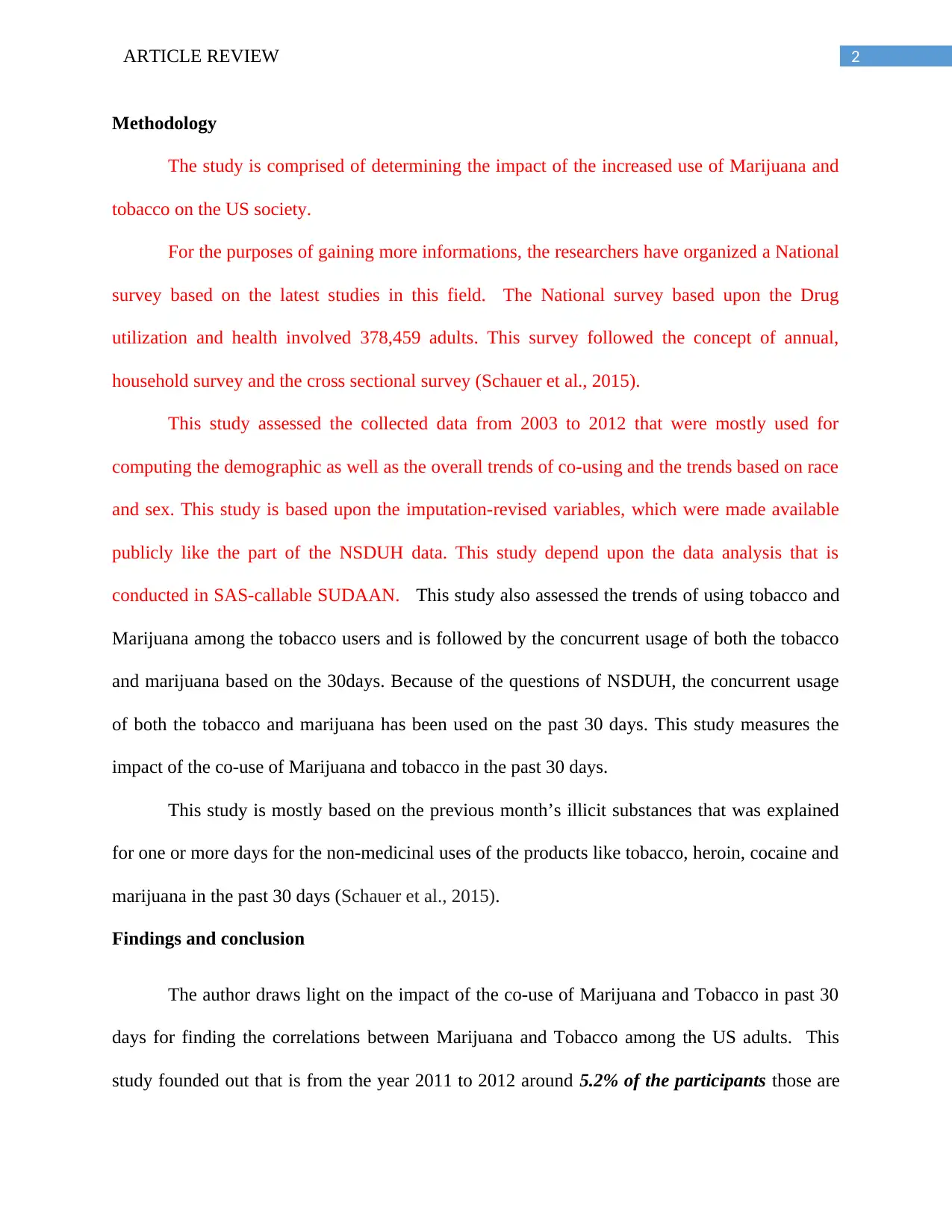
2ARTICLE REVIEW
Methodology
The study is comprised of determining the impact of the increased use of Marijuana and
tobacco on the US society.
For the purposes of gaining more informations, the researchers have organized a National
survey based on the latest studies in this field. The National survey based upon the Drug
utilization and health involved 378,459 adults. This survey followed the concept of annual,
household survey and the cross sectional survey (Schauer et al., 2015).
This study assessed the collected data from 2003 to 2012 that were mostly used for
computing the demographic as well as the overall trends of co-using and the trends based on race
and sex. This study is based upon the imputation-revised variables, which were made available
publicly like the part of the NSDUH data. This study depend upon the data analysis that is
conducted in SAS-callable SUDAAN. This study also assessed the trends of using tobacco and
Marijuana among the tobacco users and is followed by the concurrent usage of both the tobacco
and marijuana based on the 30days. Because of the questions of NSDUH, the concurrent usage
of both the tobacco and marijuana has been used on the past 30 days. This study measures the
impact of the co-use of Marijuana and tobacco in the past 30 days.
This study is mostly based on the previous month’s illicit substances that was explained
for one or more days for the non-medicinal uses of the products like tobacco, heroin, cocaine and
marijuana in the past 30 days (Schauer et al., 2015).
Findings and conclusion
The author draws light on the impact of the co-use of Marijuana and Tobacco in past 30
days for finding the correlations between Marijuana and Tobacco among the US adults. This
study founded out that is from the year 2011 to 2012 around 5.2% of the participants those are
Methodology
The study is comprised of determining the impact of the increased use of Marijuana and
tobacco on the US society.
For the purposes of gaining more informations, the researchers have organized a National
survey based on the latest studies in this field. The National survey based upon the Drug
utilization and health involved 378,459 adults. This survey followed the concept of annual,
household survey and the cross sectional survey (Schauer et al., 2015).
This study assessed the collected data from 2003 to 2012 that were mostly used for
computing the demographic as well as the overall trends of co-using and the trends based on race
and sex. This study is based upon the imputation-revised variables, which were made available
publicly like the part of the NSDUH data. This study depend upon the data analysis that is
conducted in SAS-callable SUDAAN. This study also assessed the trends of using tobacco and
Marijuana among the tobacco users and is followed by the concurrent usage of both the tobacco
and marijuana based on the 30days. Because of the questions of NSDUH, the concurrent usage
of both the tobacco and marijuana has been used on the past 30 days. This study measures the
impact of the co-use of Marijuana and tobacco in the past 30 days.
This study is mostly based on the previous month’s illicit substances that was explained
for one or more days for the non-medicinal uses of the products like tobacco, heroin, cocaine and
marijuana in the past 30 days (Schauer et al., 2015).
Findings and conclusion
The author draws light on the impact of the co-use of Marijuana and Tobacco in past 30
days for finding the correlations between Marijuana and Tobacco among the US adults. This
study founded out that is from the year 2011 to 2012 around 5.2% of the participants those are
⊘ This is a preview!⊘
Do you want full access?
Subscribe today to unlock all pages.

Trusted by 1+ million students worldwide
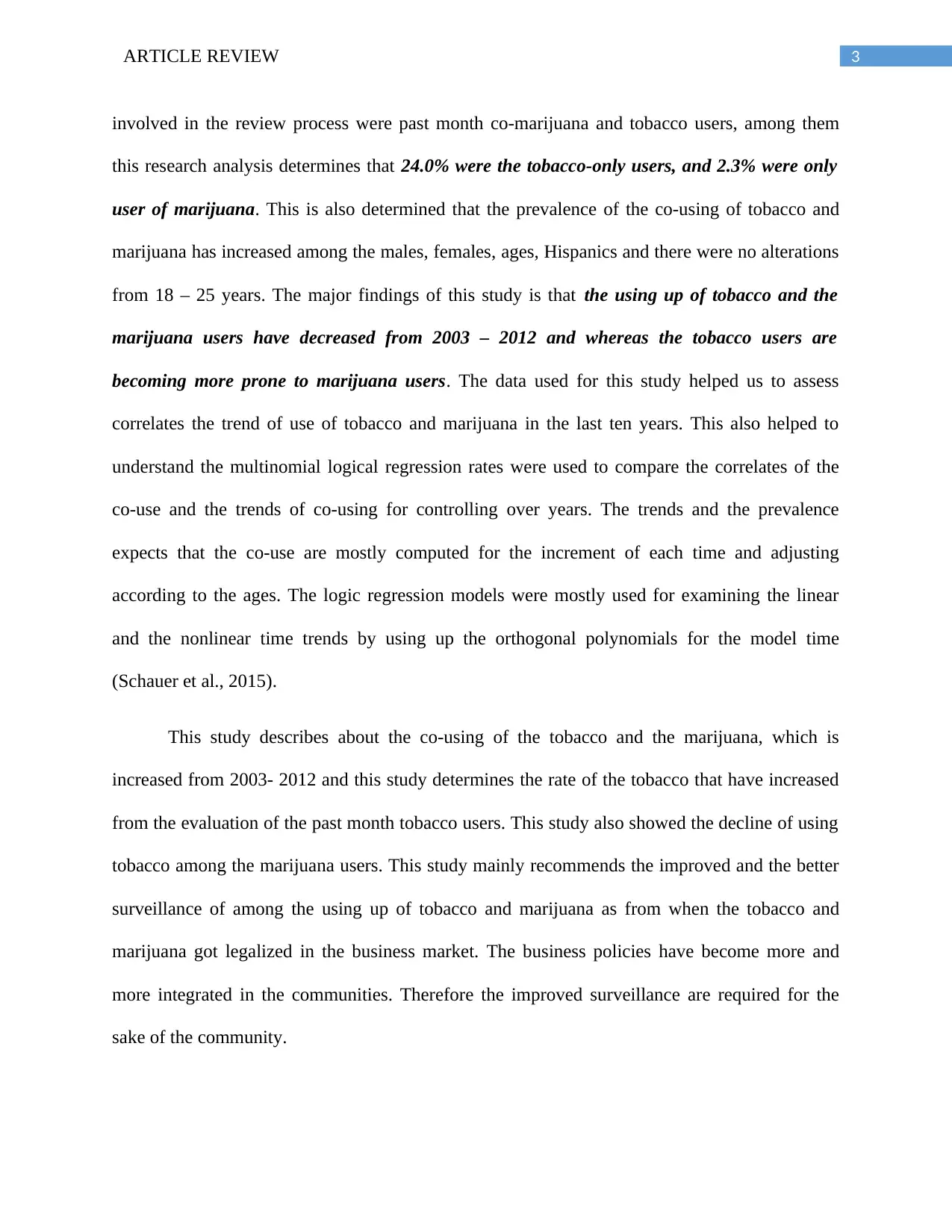
3ARTICLE REVIEW
involved in the review process were past month co-marijuana and tobacco users, among them
this research analysis determines that 24.0% were the tobacco-only users, and 2.3% were only
user of marijuana. This is also determined that the prevalence of the co-using of tobacco and
marijuana has increased among the males, females, ages, Hispanics and there were no alterations
from 18 – 25 years. The major findings of this study is that the using up of tobacco and the
marijuana users have decreased from 2003 – 2012 and whereas the tobacco users are
becoming more prone to marijuana users. The data used for this study helped us to assess
correlates the trend of use of tobacco and marijuana in the last ten years. This also helped to
understand the multinomial logical regression rates were used to compare the correlates of the
co-use and the trends of co-using for controlling over years. The trends and the prevalence
expects that the co-use are mostly computed for the increment of each time and adjusting
according to the ages. The logic regression models were mostly used for examining the linear
and the nonlinear time trends by using up the orthogonal polynomials for the model time
(Schauer et al., 2015).
This study describes about the co-using of the tobacco and the marijuana, which is
increased from 2003- 2012 and this study determines the rate of the tobacco that have increased
from the evaluation of the past month tobacco users. This study also showed the decline of using
tobacco among the marijuana users. This study mainly recommends the improved and the better
surveillance of among the using up of tobacco and marijuana as from when the tobacco and
marijuana got legalized in the business market. The business policies have become more and
more integrated in the communities. Therefore the improved surveillance are required for the
sake of the community.
involved in the review process were past month co-marijuana and tobacco users, among them
this research analysis determines that 24.0% were the tobacco-only users, and 2.3% were only
user of marijuana. This is also determined that the prevalence of the co-using of tobacco and
marijuana has increased among the males, females, ages, Hispanics and there were no alterations
from 18 – 25 years. The major findings of this study is that the using up of tobacco and the
marijuana users have decreased from 2003 – 2012 and whereas the tobacco users are
becoming more prone to marijuana users. The data used for this study helped us to assess
correlates the trend of use of tobacco and marijuana in the last ten years. This also helped to
understand the multinomial logical regression rates were used to compare the correlates of the
co-use and the trends of co-using for controlling over years. The trends and the prevalence
expects that the co-use are mostly computed for the increment of each time and adjusting
according to the ages. The logic regression models were mostly used for examining the linear
and the nonlinear time trends by using up the orthogonal polynomials for the model time
(Schauer et al., 2015).
This study describes about the co-using of the tobacco and the marijuana, which is
increased from 2003- 2012 and this study determines the rate of the tobacco that have increased
from the evaluation of the past month tobacco users. This study also showed the decline of using
tobacco among the marijuana users. This study mainly recommends the improved and the better
surveillance of among the using up of tobacco and marijuana as from when the tobacco and
marijuana got legalized in the business market. The business policies have become more and
more integrated in the communities. Therefore the improved surveillance are required for the
sake of the community.
Paraphrase This Document
Need a fresh take? Get an instant paraphrase of this document with our AI Paraphraser
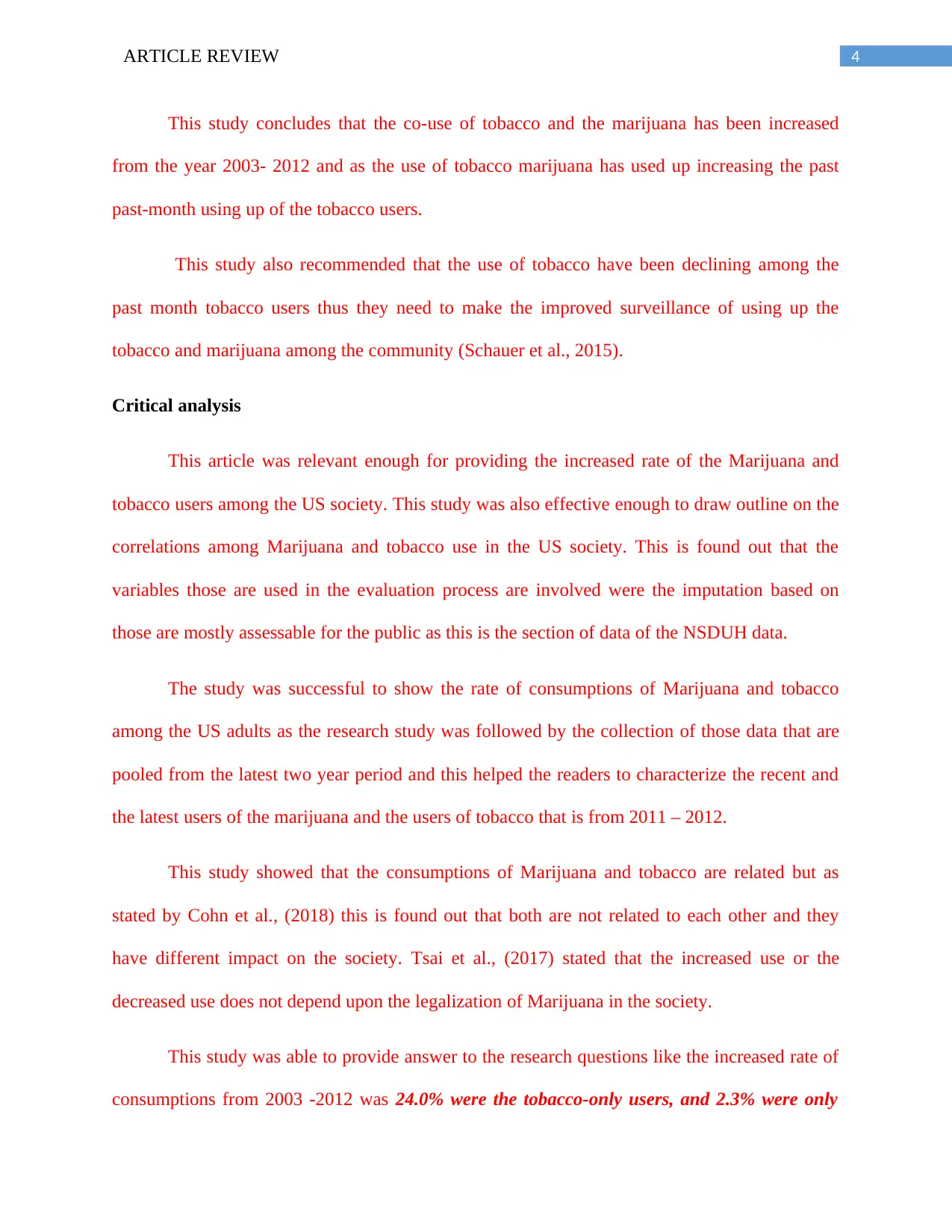
4ARTICLE REVIEW
This study concludes that the co-use of tobacco and the marijuana has been increased
from the year 2003- 2012 and as the use of tobacco marijuana has used up increasing the past
past-month using up of the tobacco users.
This study also recommended that the use of tobacco have been declining among the
past month tobacco users thus they need to make the improved surveillance of using up the
tobacco and marijuana among the community (Schauer et al., 2015).
Critical analysis
This article was relevant enough for providing the increased rate of the Marijuana and
tobacco users among the US society. This study was also effective enough to draw outline on the
correlations among Marijuana and tobacco use in the US society. This is found out that the
variables those are used in the evaluation process are involved were the imputation based on
those are mostly assessable for the public as this is the section of data of the NSDUH data.
The study was successful to show the rate of consumptions of Marijuana and tobacco
among the US adults as the research study was followed by the collection of those data that are
pooled from the latest two year period and this helped the readers to characterize the recent and
the latest users of the marijuana and the users of tobacco that is from 2011 – 2012.
This study showed that the consumptions of Marijuana and tobacco are related but as
stated by Cohn et al., (2018) this is found out that both are not related to each other and they
have different impact on the society. Tsai et al., (2017) stated that the increased use or the
decreased use does not depend upon the legalization of Marijuana in the society.
This study was able to provide answer to the research questions like the increased rate of
consumptions from 2003 -2012 was 24.0% were the tobacco-only users, and 2.3% were only
This study concludes that the co-use of tobacco and the marijuana has been increased
from the year 2003- 2012 and as the use of tobacco marijuana has used up increasing the past
past-month using up of the tobacco users.
This study also recommended that the use of tobacco have been declining among the
past month tobacco users thus they need to make the improved surveillance of using up the
tobacco and marijuana among the community (Schauer et al., 2015).
Critical analysis
This article was relevant enough for providing the increased rate of the Marijuana and
tobacco users among the US society. This study was also effective enough to draw outline on the
correlations among Marijuana and tobacco use in the US society. This is found out that the
variables those are used in the evaluation process are involved were the imputation based on
those are mostly assessable for the public as this is the section of data of the NSDUH data.
The study was successful to show the rate of consumptions of Marijuana and tobacco
among the US adults as the research study was followed by the collection of those data that are
pooled from the latest two year period and this helped the readers to characterize the recent and
the latest users of the marijuana and the users of tobacco that is from 2011 – 2012.
This study showed that the consumptions of Marijuana and tobacco are related but as
stated by Cohn et al., (2018) this is found out that both are not related to each other and they
have different impact on the society. Tsai et al., (2017) stated that the increased use or the
decreased use does not depend upon the legalization of Marijuana in the society.
This study was able to provide answer to the research questions like the increased rate of
consumptions from 2003 -2012 was 24.0% were the tobacco-only users, and 2.3% were only
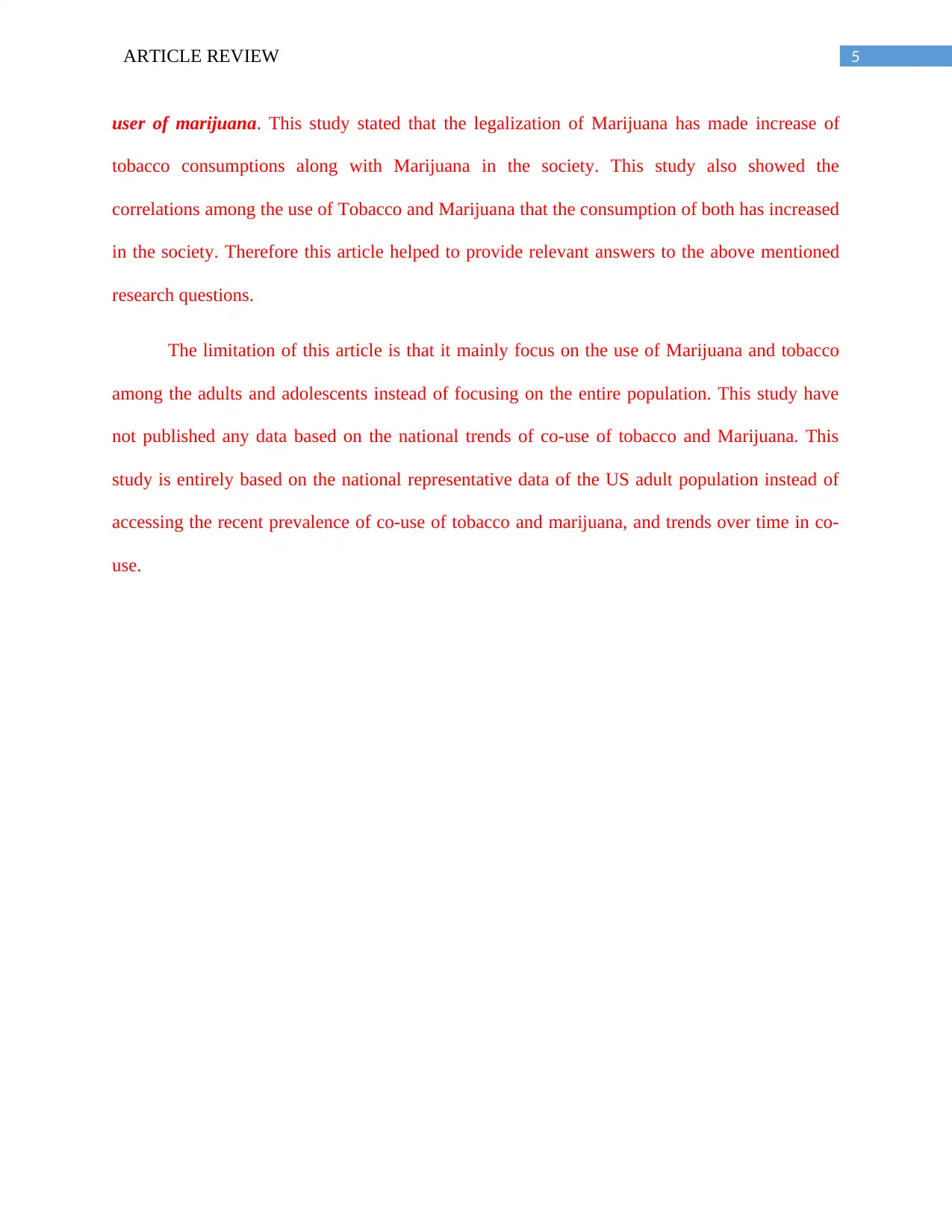
5ARTICLE REVIEW
user of marijuana. This study stated that the legalization of Marijuana has made increase of
tobacco consumptions along with Marijuana in the society. This study also showed the
correlations among the use of Tobacco and Marijuana that the consumption of both has increased
in the society. Therefore this article helped to provide relevant answers to the above mentioned
research questions.
The limitation of this article is that it mainly focus on the use of Marijuana and tobacco
among the adults and adolescents instead of focusing on the entire population. This study have
not published any data based on the national trends of co-use of tobacco and Marijuana. This
study is entirely based on the national representative data of the US adult population instead of
accessing the recent prevalence of co-use of tobacco and marijuana, and trends over time in co-
use.
user of marijuana. This study stated that the legalization of Marijuana has made increase of
tobacco consumptions along with Marijuana in the society. This study also showed the
correlations among the use of Tobacco and Marijuana that the consumption of both has increased
in the society. Therefore this article helped to provide relevant answers to the above mentioned
research questions.
The limitation of this article is that it mainly focus on the use of Marijuana and tobacco
among the adults and adolescents instead of focusing on the entire population. This study have
not published any data based on the national trends of co-use of tobacco and Marijuana. This
study is entirely based on the national representative data of the US adult population instead of
accessing the recent prevalence of co-use of tobacco and marijuana, and trends over time in co-
use.
⊘ This is a preview!⊘
Do you want full access?
Subscribe today to unlock all pages.

Trusted by 1+ million students worldwide
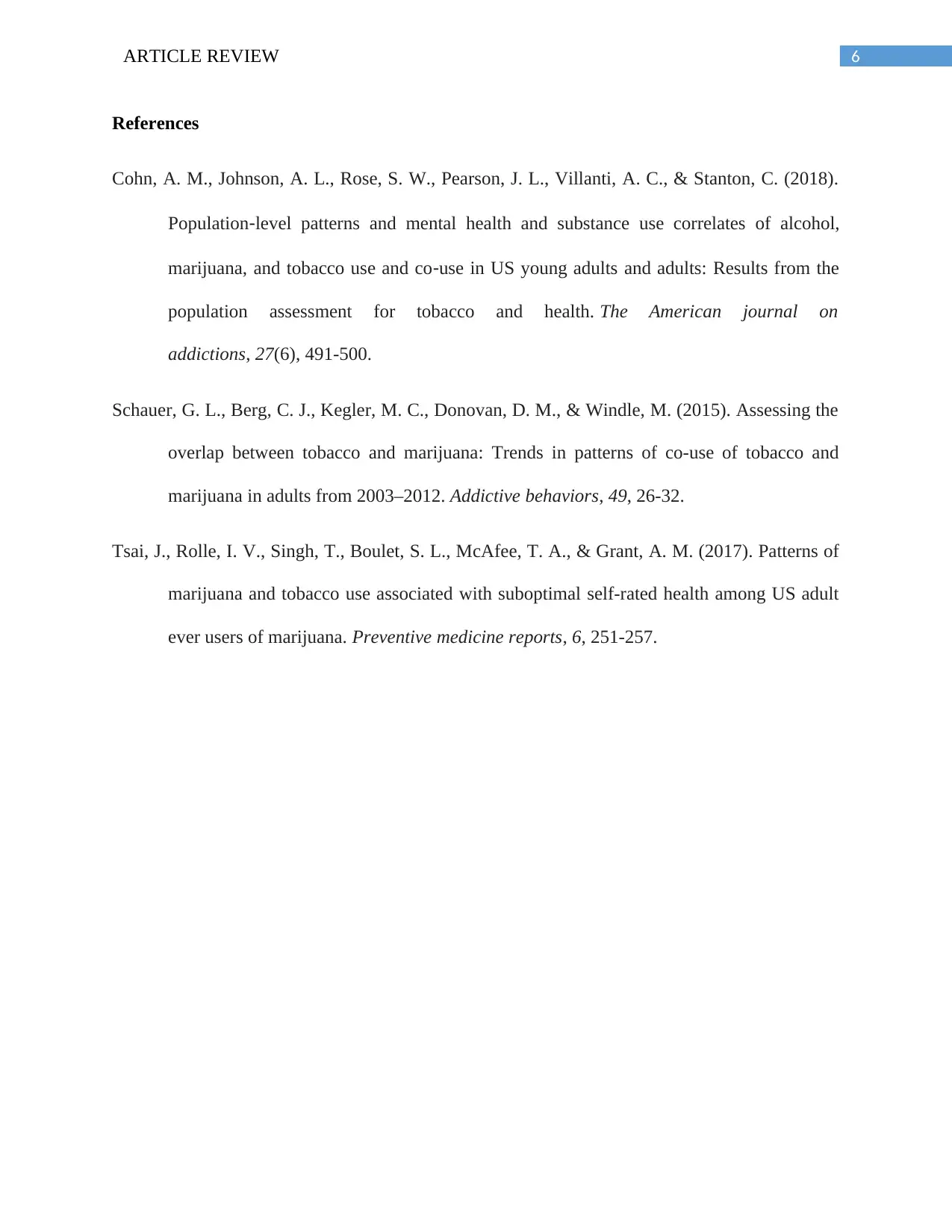
6ARTICLE REVIEW
References
Cohn, A. M., Johnson, A. L., Rose, S. W., Pearson, J. L., Villanti, A. C., & Stanton, C. (2018).
Population‐level patterns and mental health and substance use correlates of alcohol,
marijuana, and tobacco use and co‐use in US young adults and adults: Results from the
population assessment for tobacco and health. The American journal on
addictions, 27(6), 491-500.
Schauer, G. L., Berg, C. J., Kegler, M. C., Donovan, D. M., & Windle, M. (2015). Assessing the
overlap between tobacco and marijuana: Trends in patterns of co-use of tobacco and
marijuana in adults from 2003–2012. Addictive behaviors, 49, 26-32.
Tsai, J., Rolle, I. V., Singh, T., Boulet, S. L., McAfee, T. A., & Grant, A. M. (2017). Patterns of
marijuana and tobacco use associated with suboptimal self-rated health among US adult
ever users of marijuana. Preventive medicine reports, 6, 251-257.
References
Cohn, A. M., Johnson, A. L., Rose, S. W., Pearson, J. L., Villanti, A. C., & Stanton, C. (2018).
Population‐level patterns and mental health and substance use correlates of alcohol,
marijuana, and tobacco use and co‐use in US young adults and adults: Results from the
population assessment for tobacco and health. The American journal on
addictions, 27(6), 491-500.
Schauer, G. L., Berg, C. J., Kegler, M. C., Donovan, D. M., & Windle, M. (2015). Assessing the
overlap between tobacco and marijuana: Trends in patterns of co-use of tobacco and
marijuana in adults from 2003–2012. Addictive behaviors, 49, 26-32.
Tsai, J., Rolle, I. V., Singh, T., Boulet, S. L., McAfee, T. A., & Grant, A. M. (2017). Patterns of
marijuana and tobacco use associated with suboptimal self-rated health among US adult
ever users of marijuana. Preventive medicine reports, 6, 251-257.
1 out of 7
Related Documents
Your All-in-One AI-Powered Toolkit for Academic Success.
+13062052269
info@desklib.com
Available 24*7 on WhatsApp / Email
![[object Object]](/_next/static/media/star-bottom.7253800d.svg)
Unlock your academic potential
Copyright © 2020–2025 A2Z Services. All Rights Reserved. Developed and managed by ZUCOL.





